Equipment
AP Chirascan™-plus CD Spectrometer
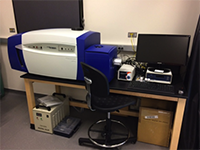 The Applied Photophysics Chirascan™-plus is designed for biopharmaceutical research and development scientists whose samples and time are at a premium. This circular dichroism spectrometer unlocks the door to a whole new approach to experimental design based on high data content, fast data acquisition, and small sample volumes. Applied Photophysics has developed Dynamic Multimode Spectroscopy (DMS) to take full advantage of the capabilities of Chirascan™-plus to deliver high-quality structural and thermodynamic data from a small sample in a single experiment. This instrument is equipped with Peltier temperature controller and a six-cell changer for economy of the sample, simultaneous measurement of circular dichroism, absorption and fluorescence, rapidity of data collection, and powerful analytical software combine to transform the type and number of CD experiments that can be carried out routinely and easily. Chirascan™-plus is an invaluable addition to the armory of biophysical techniques used to analyze the behavior of novel proteins. An optical rotatory dispersion accessory option is also available.
The Applied Photophysics Chirascan™-plus is designed for biopharmaceutical research and development scientists whose samples and time are at a premium. This circular dichroism spectrometer unlocks the door to a whole new approach to experimental design based on high data content, fast data acquisition, and small sample volumes. Applied Photophysics has developed Dynamic Multimode Spectroscopy (DMS) to take full advantage of the capabilities of Chirascan™-plus to deliver high-quality structural and thermodynamic data from a small sample in a single experiment. This instrument is equipped with Peltier temperature controller and a six-cell changer for economy of the sample, simultaneous measurement of circular dichroism, absorption and fluorescence, rapidity of data collection, and powerful analytical software combine to transform the type and number of CD experiments that can be carried out routinely and easily. Chirascan™-plus is an invaluable addition to the armory of biophysical techniques used to analyze the behavior of novel proteins. An optical rotatory dispersion accessory option is also available.
BioTek Synergy H4 Microplate Readers
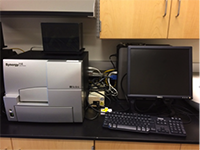 The BPC features TWO Synergy™ H4 with Hybrid Technology™ plate readers so that waiting to use a plate reader is hopefully a thing of the past! Each one of these readers is a patented multi-mode detector that combines the optical systems of Synergy Mx and Synergy 2 in one compact instrument. It is the ideal instrument for research and drug discovery applications when having to choose between flexibility and performance is not an option. The monochromator-based optics provides a high level of flexibility; any wavelength can be used from the low UV to the near-infrared. The quadruple grating optical system, equipped with a variable bandpass selection system, is ideal for spectral scanning applications. The filter-based optics use dichroic mirrors for enhanced performance. This system is faster and more sensitive than monochromator optics. This instrument is equipped with a dual reagent dispenser option that is designed to inject and read assays such as flash luminescent assays and fluorescent ion channel assays. Additional read modes include fluorescence polarization, time-resolved fluorescence, and alpha screen/AlphaLISA.
The BPC features TWO Synergy™ H4 with Hybrid Technology™ plate readers so that waiting to use a plate reader is hopefully a thing of the past! Each one of these readers is a patented multi-mode detector that combines the optical systems of Synergy Mx and Synergy 2 in one compact instrument. It is the ideal instrument for research and drug discovery applications when having to choose between flexibility and performance is not an option. The monochromator-based optics provides a high level of flexibility; any wavelength can be used from the low UV to the near-infrared. The quadruple grating optical system, equipped with a variable bandpass selection system, is ideal for spectral scanning applications. The filter-based optics use dichroic mirrors for enhanced performance. This system is faster and more sensitive than monochromator optics. This instrument is equipped with a dual reagent dispenser option that is designed to inject and read assays such as flash luminescent assays and fluorescent ion channel assays. Additional read modes include fluorescence polarization, time-resolved fluorescence, and alpha screen/AlphaLISA.
GE AKTA Pure 25 FPLC
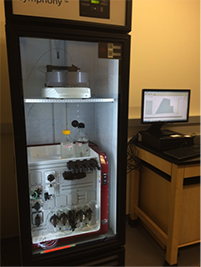 ÄKTA pure is a flexible and intuitive purification system for proteins, peptides, and nucleic acids from microgram levels to grams of target product in research applications. The ÄKTA pure 25 is designed for a broad range of applications and purification tasks in a multi-user environment. Our ÄKTA pure is refrigerated for ultimate sample stability and can be configured for a wide range of techniques, such as affinity chromatography (AC), ion-exchange chromatography (IEX), multimodal chromatography (MMC), hydrophobic interaction chromatography (HIC), and size exclusion chromatography (SEC). System hardware and software are designed to match applications utilizing the various techniques. ÄKTA pure, with a fully modular design, can be further expanded to increase flexibility and system capability. The modules are designed for easy access and quick replacement, allowing fast and efficient customization. The versatile valve is a general four-position valve that can be used to tailor the system to specific tasks, for example, for multi-step purification. Connecting and communication of external equipment, such as detectors or an autosampler, is enabled with the external equipment interface (I/O-box).
ÄKTA pure is a flexible and intuitive purification system for proteins, peptides, and nucleic acids from microgram levels to grams of target product in research applications. The ÄKTA pure 25 is designed for a broad range of applications and purification tasks in a multi-user environment. Our ÄKTA pure is refrigerated for ultimate sample stability and can be configured for a wide range of techniques, such as affinity chromatography (AC), ion-exchange chromatography (IEX), multimodal chromatography (MMC), hydrophobic interaction chromatography (HIC), and size exclusion chromatography (SEC). System hardware and software are designed to match applications utilizing the various techniques. ÄKTA pure, with a fully modular design, can be further expanded to increase flexibility and system capability. The modules are designed for easy access and quick replacement, allowing fast and efficient customization. The versatile valve is a general four-position valve that can be used to tailor the system to specific tasks, for example, for multi-step purification. Connecting and communication of external equipment, such as detectors or an autosampler, is enabled with the external equipment interface (I/O-box).
GE Ultrospec 2100 pro UV/Visible spectrophotometer
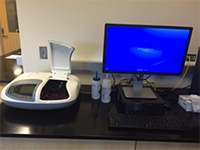 A UV/Visible spectrophotometer is an essential part of any biochemical research laboratory, so reliable access to a quality spec is essential. Anyone who depends on a UV/Vis spec to conduct research understands that when the spec is down or unavailable, research can come to a standstill. Don't worry, we got you covered! The Ultrospec 2100 Pro UV/Visible spectrophotometer is equipped with an integral graphical display, easy-to-use software, and an automated 8 cell changer making it great for any spectrophotometry application. In addition to the basic modes of absorbance, transmission, and concentration, there are routines for wavelength scanning, simple kinetics, reaction rate, standard curve, and equation entry for multiwavelength applications. There are also stored routines for nucleic acid quantitation and purity assessment; the large informative display shows all relevant results at the same time, and a nucleic acid scan routine enables visual inspection of sample integrity. Don't lose time and money waiting on your spec to become available, try the Ultrospec 2100 Pro UV/Visible spectrophotometer today!
A UV/Visible spectrophotometer is an essential part of any biochemical research laboratory, so reliable access to a quality spec is essential. Anyone who depends on a UV/Vis spec to conduct research understands that when the spec is down or unavailable, research can come to a standstill. Don't worry, we got you covered! The Ultrospec 2100 Pro UV/Visible spectrophotometer is equipped with an integral graphical display, easy-to-use software, and an automated 8 cell changer making it great for any spectrophotometry application. In addition to the basic modes of absorbance, transmission, and concentration, there are routines for wavelength scanning, simple kinetics, reaction rate, standard curve, and equation entry for multiwavelength applications. There are also stored routines for nucleic acid quantitation and purity assessment; the large informative display shows all relevant results at the same time, and a nucleic acid scan routine enables visual inspection of sample integrity. Don't lose time and money waiting on your spec to become available, try the Ultrospec 2100 Pro UV/Visible spectrophotometer today!
Olis RSM1000 Stopped-Flow Spectrophotometer
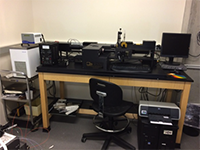 The Olis rapid scanning monochromator 1000 spectrophotometer is designed to detect kinetic reactions which occur on a millisecond timescale. This stopped-flow can detect even the subtlest UV/vis or fluorescence changes. With a routine scan rate of 1,000 scans per second, this premium quality instrument simplifies challenging studies that would otherwise require tens or hundreds of experiments to duplicate.
The Olis rapid scanning monochromator 1000 spectrophotometer is designed to detect kinetic reactions which occur on a millisecond timescale. This stopped-flow can detect even the subtlest UV/vis or fluorescence changes. With a routine scan rate of 1,000 scans per second, this premium quality instrument simplifies challenging studies that would otherwise require tens or hundreds of experiments to duplicate.
Shimadzu Prominence UFLC System
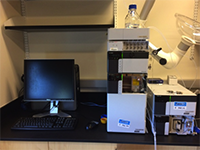 The goal of high-speed HPLC is to enhance a laboratory's productivity. The combination of Prominence UFLC and new reversed-phase columns achieves ten times higher speed compared to a conventional HPLC system. Furthermore, a high-speed sample injection mechanism significantly reduces total analytical cycle time. With this combination, Prominence UFLC offers three times higher resolution than conventional HPLC so that the possibility of analysis is increased for samples that are not sufficiently separated by conventional HPLC. The high-precision solvent delivery unit and autosampler improve repeatability in small volume sample injections for high-speed LC, achieving and maintaining excellent repeatability during long endurance tests. Prominence UFLC has superior basic performance. This instrument is equipped with a UV-VIS detector.
The goal of high-speed HPLC is to enhance a laboratory's productivity. The combination of Prominence UFLC and new reversed-phase columns achieves ten times higher speed compared to a conventional HPLC system. Furthermore, a high-speed sample injection mechanism significantly reduces total analytical cycle time. With this combination, Prominence UFLC offers three times higher resolution than conventional HPLC so that the possibility of analysis is increased for samples that are not sufficiently separated by conventional HPLC. The high-precision solvent delivery unit and autosampler improve repeatability in small volume sample injections for high-speed LC, achieving and maintaining excellent repeatability during long endurance tests. Prominence UFLC has superior basic performance. This instrument is equipped with a UV-VIS detector.
Stratagene Mx3005P qPCR System
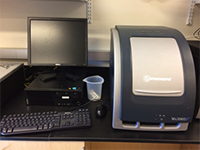 Cited in more than 3000 publications, the Agilent Mx3005P Systems is the most flexible—and reliable—instrument available for differential scanning fluorimetry (DSF), gene expression analysis, microarray data validation, SNP genotyping, pathogen detection, DNA methylation analysis, and chromatin immunoprecipitation studies. Highly reproducible results are the product of the Mx3005P’s single light source, single detector precision optic scanning design, providing uniform excitation and detection, coupled with the trusted Peltier-based thermal system, which ensures uniform ramping and thermal accuracy. Agilent’s qPCR software, MxPro, provides users with an intuitive interface, quick experiment design, powerful data analysis, and easy report generation. All of these features and more make qPCR with the Mx instrument an exciting and dependable user experience.
Cited in more than 3000 publications, the Agilent Mx3005P Systems is the most flexible—and reliable—instrument available for differential scanning fluorimetry (DSF), gene expression analysis, microarray data validation, SNP genotyping, pathogen detection, DNA methylation analysis, and chromatin immunoprecipitation studies. Highly reproducible results are the product of the Mx3005P’s single light source, single detector precision optic scanning design, providing uniform excitation and detection, coupled with the trusted Peltier-based thermal system, which ensures uniform ramping and thermal accuracy. Agilent’s qPCR software, MxPro, provides users with an intuitive interface, quick experiment design, powerful data analysis, and easy report generation. All of these features and more make qPCR with the Mx instrument an exciting and dependable user experience.
Wyatt DynaPro NanoStar Dynamic Light Scattering
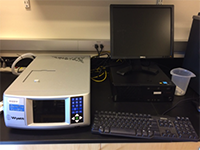 The DynaPro NanoStar is a unique cuvette-based DLS instrument used for the analysis of proteins, promiscuous inhibitors, micelles, quantum dots, liposomes, metallic nanoparticles, and more. The instrument is designed to work with any standard cuvette, but can also accommodate scarce and precious samples through specially designed quartz cuvettes which afford robust, accurate measurements with as little as 1 µL of a solution, while Wyatt proprietary disposable cuvettes provide comparable sensitivity with as little as 4 µL! Coupled with the versatile and user-friendly DYNAMICS software, the NanoStar may be utilized to measure not just size, size distributions, and weight-average molar mass, but also solution properties relevant to sample stability: the second virial coefficient (A2 or B22), the diffusion interaction parameter (kD or D1, closely related to the second virial coefficient), and the temperature of protein melting or aggregation onset (TM, Tonset).
The DynaPro NanoStar is a unique cuvette-based DLS instrument used for the analysis of proteins, promiscuous inhibitors, micelles, quantum dots, liposomes, metallic nanoparticles, and more. The instrument is designed to work with any standard cuvette, but can also accommodate scarce and precious samples through specially designed quartz cuvettes which afford robust, accurate measurements with as little as 1 µL of a solution, while Wyatt proprietary disposable cuvettes provide comparable sensitivity with as little as 4 µL! Coupled with the versatile and user-friendly DYNAMICS software, the NanoStar may be utilized to measure not just size, size distributions, and weight-average molar mass, but also solution properties relevant to sample stability: the second virial coefficient (A2 or B22), the diffusion interaction parameter (kD or D1, closely related to the second virial coefficient), and the temperature of protein melting or aggregation onset (TM, Tonset).
Malvern Viscotek SEC-MALS 20
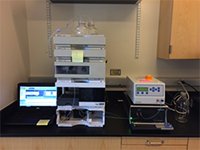 The Viscotek SEC-MALS 20 is a multi-angle light scattering detector that can be used to measure the absolute molecular weight and oligomeric state of proteins, independent of retention time. It can also be used to analyze natural and synthetic polymers, including the measurement of molecular size over the widest possible range expressed as the radius of gyration, Rg. The SEC-MALS 20 multi-angle light scattering detector is connected to the output of an HPLC system equipped with an SEC column. Signals generated from the sample passing through all detectors are analyzed by OmniSEC software consisting of 20 detectors arranged around a vertical flow cell to detect scattered light at a wide range of angles. The angular intensity and concentration information is combined to construct a plot, which is used in two ways. Firstly to extrapolate the data to determine the scattered light intensity at zero angles, from which the absolute molecular weight is calculated. Secondly to determine the initial slope of the plot which is related to the radius of gyration of the molecule (Rg). This system is equipped with a Viscotek VE3580 RI detector for the accurate determination of sample concentration.
The Viscotek SEC-MALS 20 is a multi-angle light scattering detector that can be used to measure the absolute molecular weight and oligomeric state of proteins, independent of retention time. It can also be used to analyze natural and synthetic polymers, including the measurement of molecular size over the widest possible range expressed as the radius of gyration, Rg. The SEC-MALS 20 multi-angle light scattering detector is connected to the output of an HPLC system equipped with an SEC column. Signals generated from the sample passing through all detectors are analyzed by OmniSEC software consisting of 20 detectors arranged around a vertical flow cell to detect scattered light at a wide range of angles. The angular intensity and concentration information is combined to construct a plot, which is used in two ways. Firstly to extrapolate the data to determine the scattered light intensity at zero angles, from which the absolute molecular weight is calculated. Secondly to determine the initial slope of the plot which is related to the radius of gyration of the molecule (Rg). This system is equipped with a Viscotek VE3580 RI detector for the accurate determination of sample concentration.
Malvern Zetasizer Nano Z
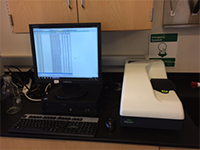 The Zetasizer Nano Z system is dedicated to the measurement of zeta potential and electrophoretic mobility in aqueous and non-aqueous dispersions using Laser Doppler Micro-Electrophoresis. It is the perfect system for measuring zeta potential and electrophoretic mobility of colloids and nanoparticles when the measurement of size or molecular weight is not required. Laser Doppler Micro-electrophoresis is used to measure zeta potential. An electric field is applied to a solution of molecules or a dispersion of particles, which then move with a velocity related to their zeta potential. This velocity is measured using a patented laser interferometric technique called M3-PALS (Phase analysis Light Scattering). This enables the calculation of electrophoretic mobility, and from this, the zeta potential and zeta potential distribution. A ‘Quality Factor’ and ‘Expert Advice System’ give the confidence of having an expert at your shoulder.
The Zetasizer Nano Z system is dedicated to the measurement of zeta potential and electrophoretic mobility in aqueous and non-aqueous dispersions using Laser Doppler Micro-Electrophoresis. It is the perfect system for measuring zeta potential and electrophoretic mobility of colloids and nanoparticles when the measurement of size or molecular weight is not required. Laser Doppler Micro-electrophoresis is used to measure zeta potential. An electric field is applied to a solution of molecules or a dispersion of particles, which then move with a velocity related to their zeta potential. This velocity is measured using a patented laser interferometric technique called M3-PALS (Phase analysis Light Scattering). This enables the calculation of electrophoretic mobility, and from this, the zeta potential and zeta potential distribution. A ‘Quality Factor’ and ‘Expert Advice System’ give the confidence of having an expert at your shoulder.
Wyatt Dynapro Plate Reader
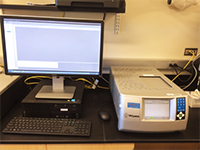 The DynaPro Plate Reader offers dynamic light scattering (DLS) measurements of the size and interactions of proteins, nanoparticles, and other macromolecules in situ in industry-standard microwell plates. No liquid handling occurs after dispensing into the plates, to maximize throughput and minimize sample carryover. The DynaPro Plate Reader provides unparalleled levels of ease-of-use, productivity, reproducibility, and flexibility in order to address additional demanding applications such as: optimizing protein crystallization, assessing aggregation or oligomerization, determining protein stability-indicating parameters such as thermal denaturation and colloidal stability, and screening high-concentration protein solutions for reversible association and viscosity. Additionally, this ground-breaking instrument provides rapid optimization of the formulation process for biotherapeutics such as monoclonal antibodies and virus-like particles (VLPs), nanoparticle drug delivery vehicles including liposomes, and conjugated gold NPs, polymer-encapsulated drug particles. Key features include: measure hydrodynamic radius from 0.5 nm to 1000 nm, sensitivity down to 0.125 mg/mL lysozyme, industry-standard microwell plates of 96, 384, or 1536 wells, all measurements made in situ in the wells, temperature ramps from 4°C to 85°C.
The DynaPro Plate Reader offers dynamic light scattering (DLS) measurements of the size and interactions of proteins, nanoparticles, and other macromolecules in situ in industry-standard microwell plates. No liquid handling occurs after dispensing into the plates, to maximize throughput and minimize sample carryover. The DynaPro Plate Reader provides unparalleled levels of ease-of-use, productivity, reproducibility, and flexibility in order to address additional demanding applications such as: optimizing protein crystallization, assessing aggregation or oligomerization, determining protein stability-indicating parameters such as thermal denaturation and colloidal stability, and screening high-concentration protein solutions for reversible association and viscosity. Additionally, this ground-breaking instrument provides rapid optimization of the formulation process for biotherapeutics such as monoclonal antibodies and virus-like particles (VLPs), nanoparticle drug delivery vehicles including liposomes, and conjugated gold NPs, polymer-encapsulated drug particles. Key features include: measure hydrodynamic radius from 0.5 nm to 1000 nm, sensitivity down to 0.125 mg/mL lysozyme, industry-standard microwell plates of 96, 384, or 1536 wells, all measurements made in situ in the wells, temperature ramps from 4°C to 85°C.




